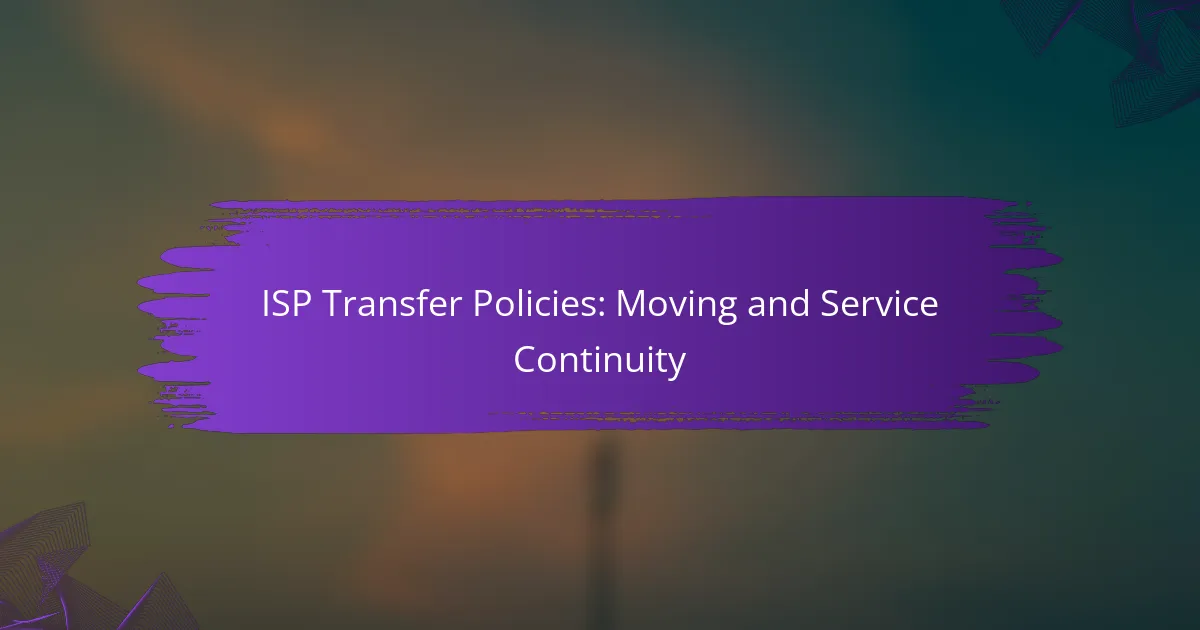Transferring your ISP in the UK requires careful planning to ensure uninterrupted service during the switch. Familiarizing yourself with the specific policies of your current and new providers, such as notice periods and potential fees, can facilitate a smooth transition. By coordinating the timing of your old and new services, you can minimize downtime and maintain continuous internet access.
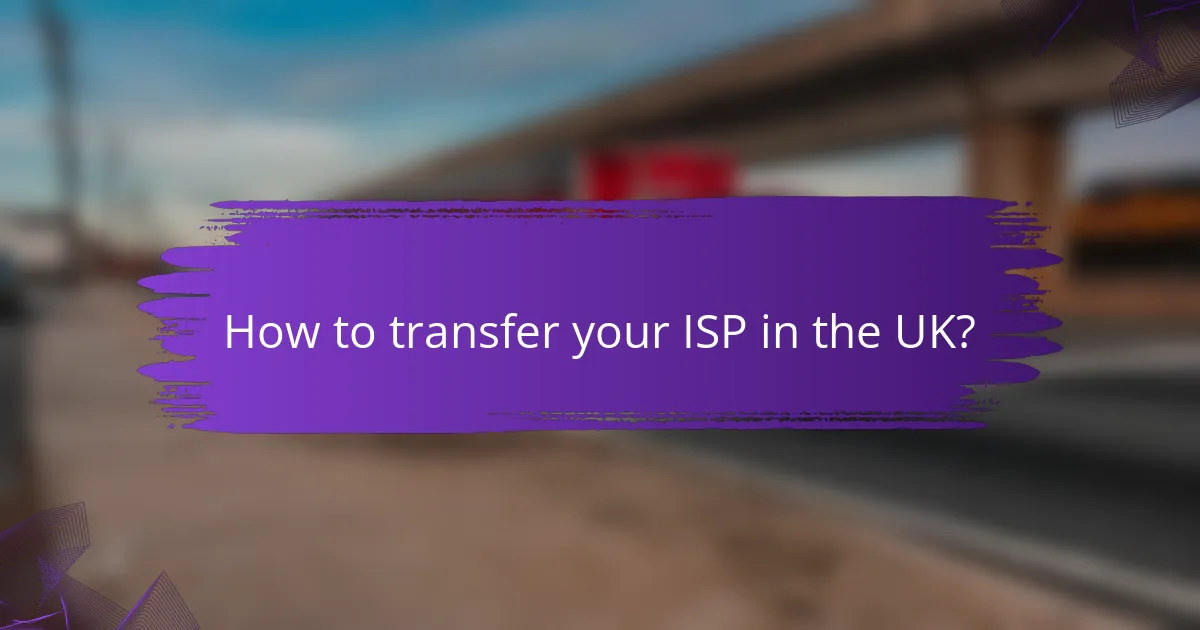
How to transfer your ISP in the UK?
Transferring your ISP in the UK involves notifying your current provider, selecting a new one, and ensuring that your service remains uninterrupted during the switch. Understanding the steps and timelines can help you manage the process smoothly.
Contact your current ISP
Start by reaching out to your current ISP to inform them of your intention to switch. This step is crucial as they may have specific requirements or notice periods that you need to adhere to. Be prepared to provide your account details and any relevant information they may request.
Check if your current ISP has any early termination fees or outstanding balances that could affect your transfer. Knowing these details upfront can help you avoid unexpected charges later on.
Choose a new ISP
Research potential new ISPs to find one that meets your needs in terms of speed, reliability, and pricing. Compare packages and read customer reviews to gauge service quality. Many ISPs offer promotional rates for new customers, which can be beneficial.
Consider the type of connection you prefer, such as fiber, cable, or DSL, as this can impact your internet experience. Make sure the new ISP provides coverage in your area to avoid any service issues.
Initiate the transfer process
Once you have chosen a new ISP, contact them to initiate the transfer process. They will guide you through the necessary steps and may handle the communication with your current provider on your behalf. Typically, you will need to provide your current account information and confirm your new service plan.
Be aware that the transfer process can take anywhere from a few days to a couple of weeks, depending on the ISPs involved. Keep track of the timeline to ensure a smooth transition.
Confirm service continuity
Before your current service ends, confirm that your new ISP is set up and ready to go. This includes ensuring that your equipment is installed and functioning correctly. You can often schedule the installation to coincide with the end of your current service.
Test your new connection as soon as it is live to ensure everything is working properly. If you experience any issues, contact your new ISP immediately for assistance. This proactive approach helps minimize downtime and ensures a seamless transition.
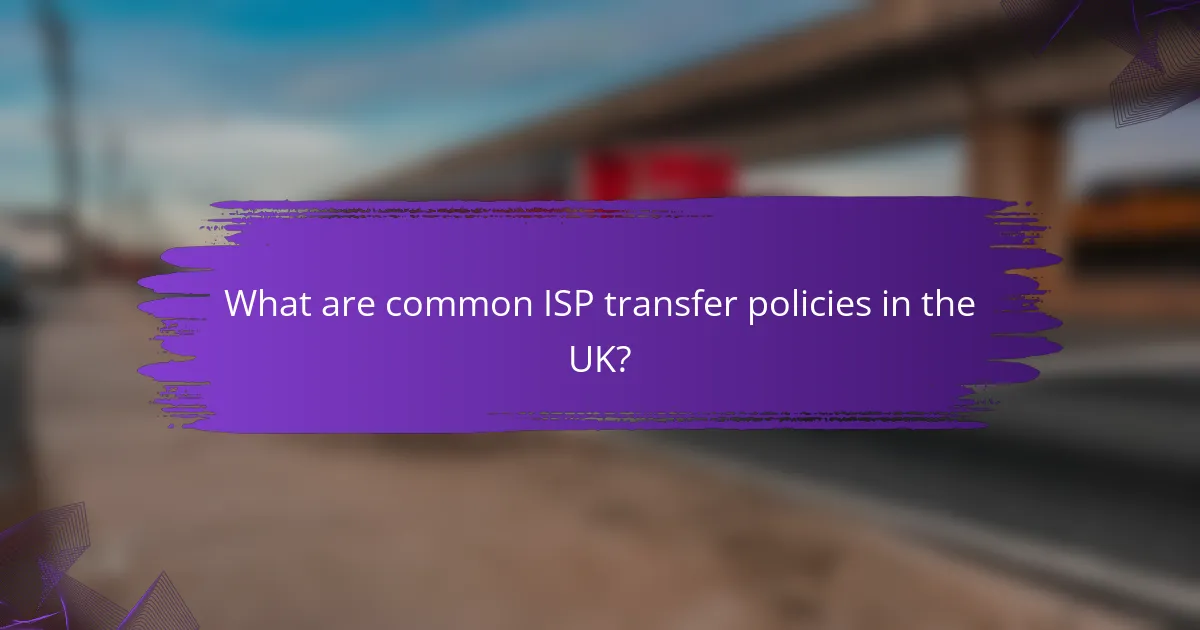
What are common ISP transfer policies in the UK?
In the UK, common ISP transfer policies include specific notice periods, potential early termination fees, and requirements for returning equipment. Understanding these policies helps ensure a smooth transition when changing internet service providers.
Notice periods
Notice periods refer to the time you must inform your current ISP before switching to a new provider. Typically, this period ranges from 30 to 60 days, depending on the ISP’s terms and conditions.
It’s crucial to check your contract for the exact notice period, as failing to provide adequate notice may result in additional charges or complications during the transfer process.
Early termination fees
Early termination fees (ETFs) may apply if you cancel your service before the end of your contract. These fees can vary widely, often ranging from £30 to £200, depending on how much time is left on your contract.
To avoid unexpected costs, review your contract for any ETF clauses and consider timing your switch to coincide with the end of your contract whenever possible.
Equipment return requirements
Most ISPs require you to return any rented equipment, such as routers or modems, upon cancellation of service. Failure to return this equipment can lead to additional charges, often around £50 or more.
Check your ISP’s policy regarding equipment returns, including any deadlines and shipping instructions, to ensure you comply and avoid unnecessary fees.
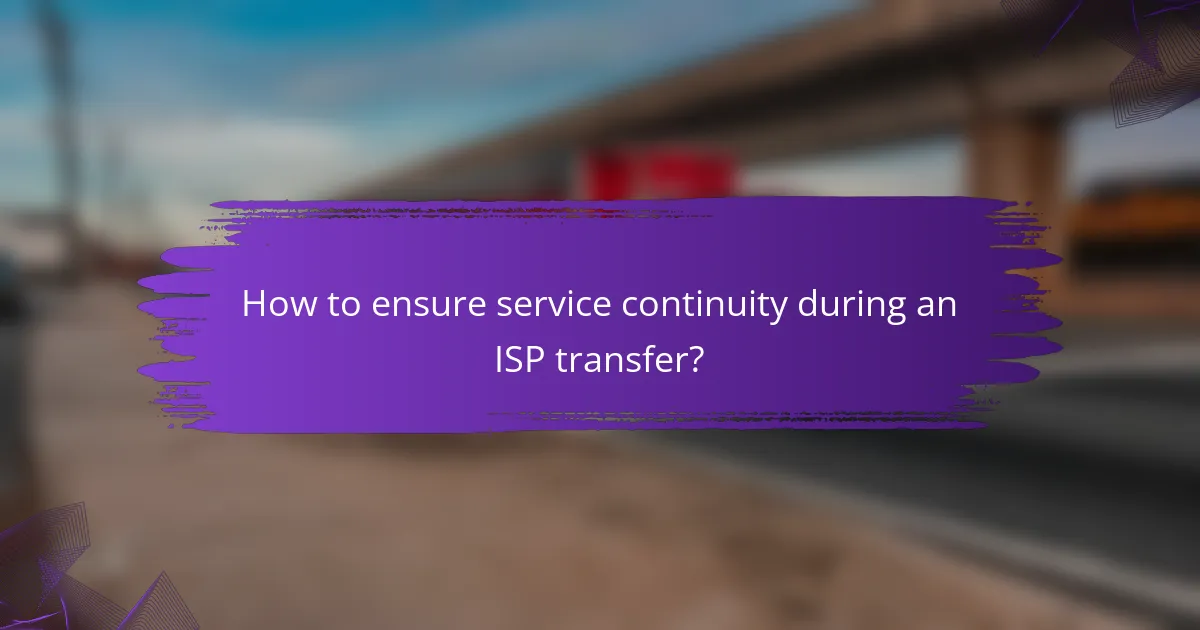
How to ensure service continuity during an ISP transfer?
To ensure service continuity during an ISP transfer, it’s crucial to plan ahead and coordinate the timing of your old and new services. This minimizes downtime and maintains internet access throughout the transition.
Overlap service periods
Overlapping service periods is a key strategy for maintaining internet access during an ISP transfer. By keeping both your old and new services active for a short time, you can test the new connection while still having access to the old one.
Consider scheduling the new service to start a few days before the old service ends. This overlap can help identify any issues with the new ISP before fully committing to the switch.
Schedule installation in advance
Scheduling installation in advance is essential to avoid gaps in service. Contact your new ISP to arrange for installation at least a week before you plan to disconnect your current service.
During the scheduling process, confirm the technician’s availability and any necessary equipment. This proactive approach helps ensure that the installation aligns with your timeline, reducing the risk of service interruptions.
Use temporary mobile hotspots
Using temporary mobile hotspots can provide a reliable backup during the ISP transfer. If there’s a delay in the installation of your new service, a mobile hotspot can keep you connected for essential tasks.
Consider purchasing a mobile data plan that offers sufficient data for your needs. Many providers offer flexible plans that can be activated quickly, ensuring you stay online while transitioning between ISPs.
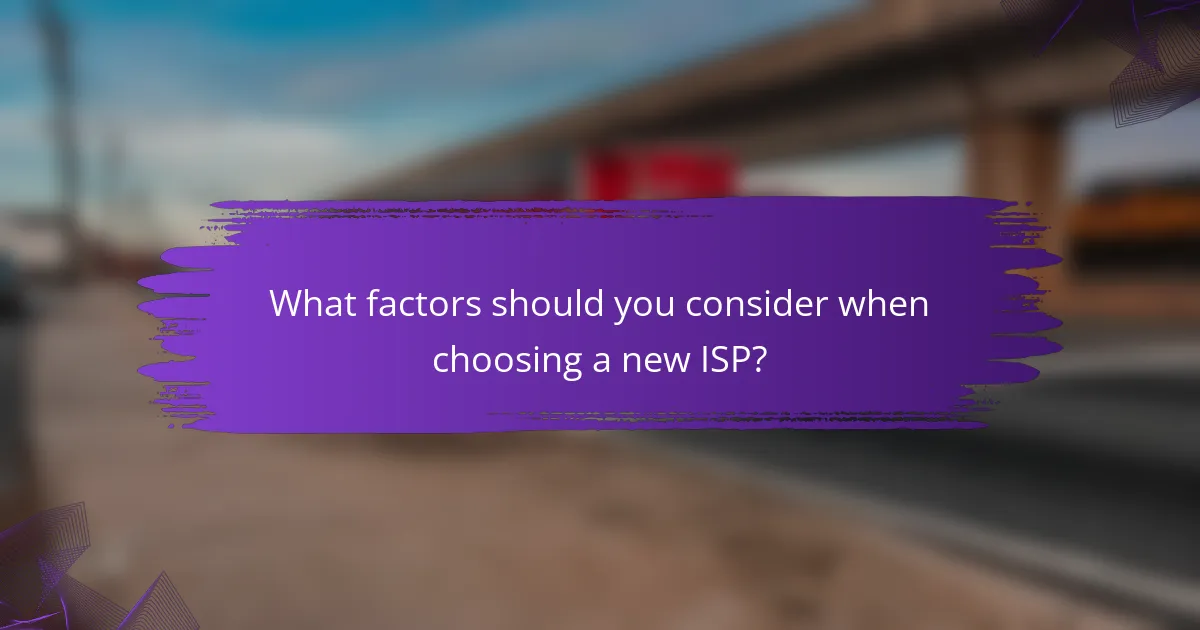
What factors should you consider when choosing a new ISP?
When selecting a new Internet Service Provider (ISP), consider factors such as speed, contract terms, and customer support. These elements significantly influence your overall satisfaction and service continuity during the transition.
Speed and bandwidth
Speed and bandwidth are critical when evaluating an ISP. Look for plans that offer sufficient download and upload speeds to meet your household’s needs, especially if multiple users stream, game, or work from home. Generally, a minimum of 25 Mbps is recommended for basic use, while higher demands may require 100 Mbps or more.
Additionally, consider the bandwidth limits. Some ISPs impose data caps, which can lead to throttling or extra charges if exceeded. Always check the fine print to avoid unexpected costs.
Contract length and flexibility
Contract length and flexibility are essential factors when choosing an ISP. Many providers offer contracts ranging from one to two years, often with promotional pricing for the first few months. Evaluate whether you are comfortable committing to a long-term contract or if you prefer a month-to-month option that allows for easier changes in the future.
Be aware of early termination fees, which can be substantial. If you anticipate moving or changing your service needs, look for ISPs that offer flexible terms or no contracts at all.
Customer support reputation
Customer support reputation can significantly impact your experience with an ISP. Research online reviews and ratings to gauge how responsive and helpful the provider’s support team is. Look for ISPs that offer multiple support channels, such as phone, chat, and email, to ensure you can reach them easily when issues arise.
Consider the availability of local technicians for installations and repairs, as prompt service can minimize downtime. A provider with a strong customer support track record can save you time and frustration in the long run.

What are the implications of transferring ISPs for businesses?
Transferring ISPs can significantly impact business operations, data security, and service continuity. Understanding these implications is crucial for ensuring a smooth transition and minimizing disruptions.
Impact on business operations
Changing ISPs can affect various aspects of business operations, including internet speed, reliability, and customer service. Businesses should assess the new provider’s service level agreements (SLAs) to ensure they meet operational needs.
It’s advisable to compare the features offered by the new ISP, such as bandwidth options and customer support availability, to avoid any negative impact on productivity. A well-planned transition can help maintain seamless operations.
Data security considerations
Data security is a critical concern when transferring ISPs, as different providers may have varying security protocols. Businesses should ensure that the new ISP complies with relevant regulations and offers robust security measures, such as encryption and firewalls.
Before the transfer, review the current data protection policies and ensure that sensitive information remains secure during the transition. Conducting a risk assessment can help identify potential vulnerabilities associated with the new provider.
Potential downtime risks
Downtime during an ISP transfer can lead to lost revenue and decreased customer satisfaction. Businesses should plan the transition carefully to minimize service interruptions, ideally scheduling the switch during off-peak hours.
It’s wise to maintain a backup connection during the transfer process to ensure continued access to the internet. Communicating with employees and customers about potential downtime can help manage expectations and reduce frustration.

How do different ISPs compare in terms of transfer policies?
ISPs vary significantly in their transfer policies, impacting how easily customers can switch providers while maintaining service continuity. Key factors include transfer fees, contract terms, and the speed of the transfer process.
Transfer Fees and Charges
Transfer fees can differ widely among ISPs, with some charging a flat fee while others may impose penalties for early contract termination. It’s essential to review your current contract to understand any potential costs associated with switching providers.
For example, some ISPs may offer to waive transfer fees if you sign a new contract with them, while others might charge anywhere from $50 to $200. Always inquire about these fees before initiating a transfer.
Contract Terms and Conditions
Each ISP has unique contract terms that can affect your ability to transfer services. Many providers require a minimum commitment period, which can range from one to two years.
Be aware that some ISPs may have specific clauses that could complicate the transfer process, such as requiring you to fulfill your current contract before switching. Reading the fine print can save you from unexpected issues.
Transfer Process Duration
The duration of the transfer process can vary, typically taking anywhere from a few days to a couple of weeks. Factors influencing this timeline include the complexity of your current setup and the responsiveness of both ISPs.
To expedite the transfer, ensure that you have all necessary information ready, such as account numbers and identification. Contact both your current and new ISP to confirm the steps involved and any potential delays.
